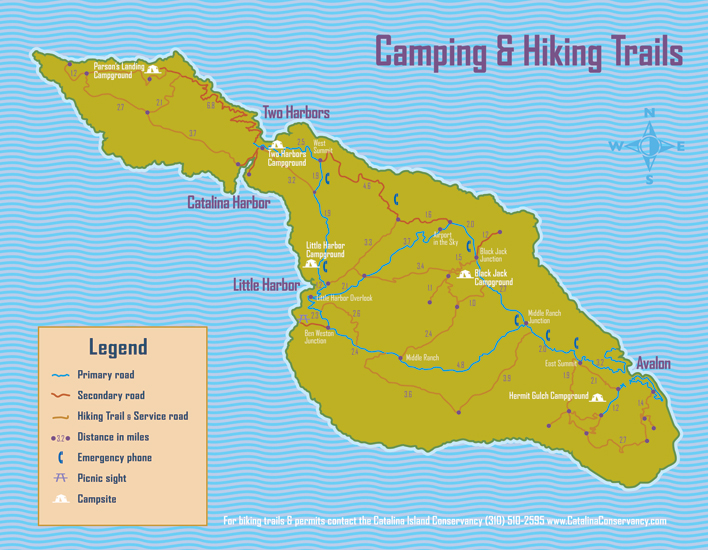SANTA CATALINA ISLAND
Santa Catalina Island Conservancy Map
This map is water proof and includes info about dive site and what game fish and wildlife in the water and where to adventure in the water in the area specifically. While camping there I picked a ton of wild endemic cherries from numerous trees this summer and fall which were delicious yet have huge seeds like alot of wild fruits have. Prickly pear cactus are abundant and spearfishing is a great way to catch dinner. I ate pounds of grilled and sushi style halibut (with soy sauce and wasabi) perch, and bass etc. while camping, kayaking, and body surfing in clean water within Shark Harbor at Little Harbor campground......highly recommended. Lobster season starts in October in CALI! The grounds have outdoor showers and 80 year old palm trees there from an old Hollywood movie set. You can ride your mountain bike there, hike, or take an infrequent bus from either Avalon or Two Harbors for a fee.
1. Catalina Island is located in and 19.7 miles off the coast of Los Angeles County at Lat 33 Degrees N and 118 Degrees W. It is about 21 miles long and 8 miles wide at its widest point. Its highest peak is Mt Orizaba at 2097 ft. It has a total land area of 75 sq. mi and 54 miles of coastline. The island has an average of 267 days of sunshine each year.
Average temperature of the air is 68F with Summer at 73F and Winter at 53F
Average water temperature is at 69F in Summer and 58F during Winter
It has two towns, Avalon which has 3,500 living in it yearound and Two Harbors which has about 165.
The island is in both the California and Southwest region of the United States and has a Mediterranean climate with a mild winter with minimal rain and dry summers.
The island has an increase level of fog during late spring and early summer called June gloom, like southern CA itself.
The worst storms are called Nor'easters and produce large waves on the leeward side facing the coast of CA where it is normally calm.
The island is surrounded by many kelp beds which provide habitat for many species which include fish: barracuda, various bass species, cod, croakers, flatfish, dolphin fish, rays, rockfish, sardines, sharks, perch etc. Invertebrates include crabs, shrimp, barnacles, and worms in addition to anemones, corals, urchins, statfish and sea fans. Sea Turtles, dophins, porpoises, and whales are abundant as well.
What makes Catalina Island really special for me is the relatively clean water compared with the polluted CA coastline and its toxic runoff and places to camp and stay at hotels (primarily in Avalon and one place in Two Harbors.
Catalina Island's first inhabitants migrated from southern Oregon and the largest group were the Chumash about 8,000 yrs ago. Later, the Shono speakers from the Great Basin replaced them and the Tongva thrived ("The people of the earth"). They used canoes made primarily from redwood from the north to travel to and from the mainland CA.
The first white man who 'discovered' was Juan Cabrillo in 1542 claiming it for Spain. Sea otter hunters from Russia and the Aleutian islands hunted seals and soon the Native peoples died from diseases or were transfered to missions.
Thomas Robbins was the first owner when Mexico took control in 1820 and was used for ranching primarily and smugglers avoiding taxes.
After more ownership transfers, the Wrigley family from Chicago purchased the island and developed it for tourists, Hollywood stars, movie backdrops, a game preserve, training for soldiers during World War 11, and the Chicago Cubs went there for spring training.
In 1975 the Wrigleys gave 88% of the island to the Santa Catalina Island Conservancy which has an environmental school operated by USC now and dozens of wild buffalo left from a Hollywood movie set back in the 1920's. Many activites are enjoyed now such as world class scuba diving, snorkeling, sailing, surfing, hiking, mountain biking birding etc.
The airport accomadates the well to do class and Avalon has all the modern amenities one would need and an active nightlife with a nationally known smooth jazz festival every fall for the Kenny G types. Fortunately, much of the rest of the island is in a relatively natural state.











